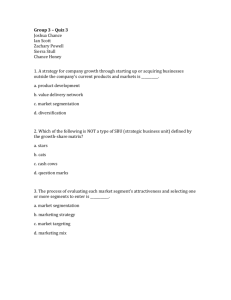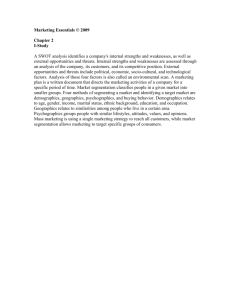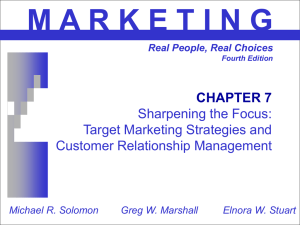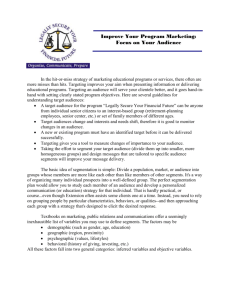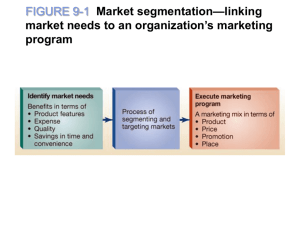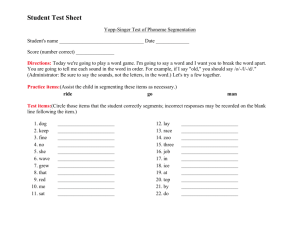Chap 7 Slide Deck
advertisement
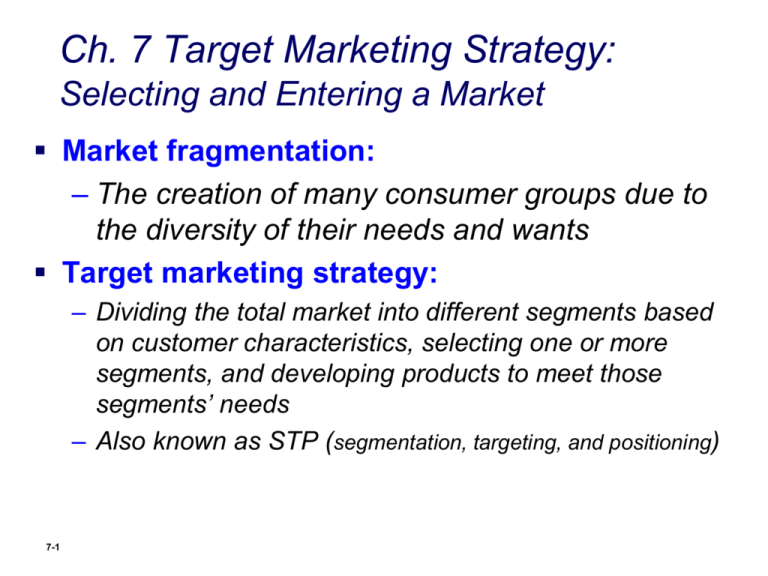
Ch. 7 Target Marketing Strategy: Selecting and Entering a Market Market fragmentation: – The creation of many consumer groups due to the diversity of their needs and wants Target marketing strategy: – Dividing the total market into different segments based on customer characteristics, selecting one or more segments, and developing products to meet those segments’ needs – Also known as STP (segmentation, targeting, and positioning) 7-1 Steps in the Target Marketing Process: STP 7-2 Goals of Segmentation Why? – Effectiveness – Efficiency – Better meets consumer needs What makes a good segmentation outcome? – p. 213, “Without real differences in consumer needs, firms might as well use a mass-marketing strategy.” – Differentiate groups based on what and why they buy Exercise: Bicycles 7-3 Steps in the Target Marketing Process Step 1: Segmentation Segmentation: – The process of dividing a larger market into smaller pieces based on one or more meaningful shared characteristics Segmentation variables (“bases”): – Dimensions that divide the total market into fairly homogeneous groups, each with different needs and preferences – Segmentation variables include: • Demographics—size, age, gender, ethnic group, income, education, occupation, family structure • Psychographics—psychological, values and lifestyles, and AIO factors • Behavior-based variables – usage rate, usage occasion, product benefits 7-4 Demographic Dimensions 7-5 Age Gender Occupation Family structure Income and social class Race and ethnicity Geography Segmenting by Demographics: Age: Generational Marketing Children Tweens Teens Generation Y: born between 1977 – ? (also referred to as Millennials) Generation X: born between 1965 - 1976 Baby Boomers: born between 1946 - 1964 Older consumers 7-6 6 Segmenting by Demographics: Gender & Other Many products appeal solely or more to one gender than the other Family Structure Income Social Class Race and Ethnicity – African Americans – Asian Americans – Hispanic Americans 7-7 7 Segmenting by Geography Geodemography: – combines Geography with demographics (*and psychographics*) – Claritas, PRIZM, etc. – Example: Children’s World prospect targeting Geocoding: – Customizes web advertising so people who log on in different places see ad banners for local businesses 7-8 8 Missoula, MT 59802's Most common PRIZM NE Segments are: 47 City Startups 56 Crossroads Villagers 53 Mobility Blues 44 New Beginnings 60 Park Bench Seniors Potential Issues: Mistargeting – Karen’s experience in Denver 7-9 Segmenting by Psychographics Psychographics: – Segments formed on the basis of values and lifestyles (VALs) and shared activities, interests, and opinions (AIOs). 7-10 10 Segmenting by Behavior Segments consumers based on how they act toward, feel about, or use a specific product category – 80/20 rule: 20 percent of purchasers account for 80 percent of a product’s sales • Heavy, medium, light users & nonusers of a product 7-11 11 Segmenting by Behavior (Cont.) User status: – Heavy, medium, and light users and nonusers of a product Usage occasions – Segments on the basis of different occasions when customers buy or use various products • Shoes, watches Benefit segmentation (not explicit in text) – Segments on the basis of the specific benefits different customers desire when purchasing in a product category: • OJ example p. 211: added vitamins/calcium vs. pulp vs. no sugar 7-12 Segmenting Business-toBusiness Markets North American Industry Classification System (NAICS) – Issues with accuracy – Inaccuracy example: candles categorized as part of petroleum, oil, and gas industry 7-13 13 Steps in the Target Marketing Process Step 2: Targeting Targeting: – Marketers evaluate the attractiveness of each potential segment and decide in which segment(s) they will invest resources toward om attempt to convert them into customers – The customer group(s) selected are referred to as the target market 7-14 Developing Segment Profiles A profile is a description of the “typical” customer in a segment. – Might include information on demographics, location, lifestyle, and product-usage frequency Some creatives (creative team in ad agency or internal agency) create a “person” that represents the target market and write ads as if writing to that person specifically 7-15 15 Evaluation of Market Segments A viable target segment should: – Have members with similar product needs and wants – Be measurable in size and purchasing power – Be large enough to be profitable – Be reachable by marketing communications – Be one that the marketer’s company has the strengths and capabilities to adequately serve well Also consider: * growth rates by segment * competition by segment 7-16 Select a Target Marketing Strategy 7-17 Choosing a Targeting Strategy Undifferentiated targeting strategy – Appealing to the total market without regard to specific segments – “Mass marketing” – Commodities, often non-profit / “social” marketing causes, limited marketing budget, lack or knowledge Differentiated targeting strategy – Developing one or more products for each of several customer groups • Example: Honda (or any major automaker) – Developing different advertising strategies (message/media) for different customer groups (but offering the same product) 7-18 • Example: Johnson’s Baby Shampoo Choosing a Targeting Strategy Concentrated (“niche) target marketing strategy – Offering one or more products to a single segment • Example: niche automaker like Rolls Royce or Ferrari Custom marketing strategy – Tailoring specific products to individual customers • Example: custom tailored suits – Common in personal and professional services • Example: dentistry, website design – Mass customization • Modifying a basic good or service that is “mass produced” to meet the specific needs of an individual Example: Vistaprint 7-19 Step 3: Positioning What is positioning? – Developing the (a) image of the product (b) in the mind of the customer (c) relative to competition on (d) important attributes (either objective or subjective) Brand personality – A distinctive image that captures the brand’s character and benefits Repositioning – Create a new position to respond to market changes 7-20 • Example: Revitaling 40 year old brand, Old Spice, with the “Smell Like a Man” campaign • http://www.dandad.org/en/old-spice-response-campaign/ 20 Steps in Developing a Positioning Strategy Analyze competitors’ positions Offer a good or service with a competitive advantage (also called point of differentiation) Finalize the marketing mix by matching mix elements to the selected segment Evaluate target market’s responses and modify strategies as needed 7-21 Positioning Tool: Perceptual Map* A research technique marketers use to identify where products/brands are “located” in consumers’ minds (i.e. how they are perceived) Statistical method: – multi-dimensional scaling – pair-wise similarity judgments A 2-dimensional “product” space – the dimensions are attributes of the product • objective or subjective – products are the evoked set 7-22 22 Example of Perceptual Map - 1 7-23 23 Example of Perceptual Map - 2 7-24 24 Four Steps in One-to-One Marketing Identify customers and get to know them in as much detail as possible Differentiate customers by their needs and value to the company Interact with customers; find ways to improve cost efficiency and the effectiveness of the interaction Customize some aspect of the products you offer each customer 7-25 CRM: A New Perspective on an Old Problem CRM systems use computers, software, databases, and the Internet to capture information at each touchpoint – Touchpoints are any direct interface between customers and a company (online, by phone, in person, etc.) 7-26 Characteristics of CRM Share of customer (vs. share of market): focus on retention and loyalty (vs. acquisition of new customers) – 7 to 10 times more expensive to acquire a new customer and retain an existing one Lifetime value of the customer – aka customer equity Focus on high-value customers – tiers/categories Personalize/customize – one-to-one marketing 7-27 27




